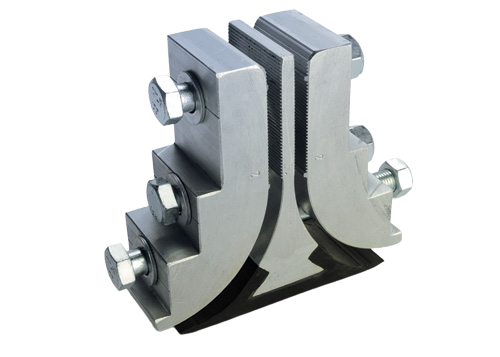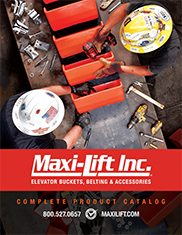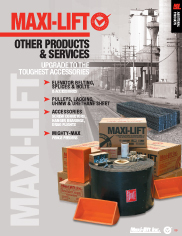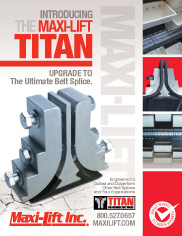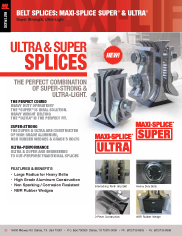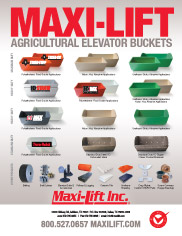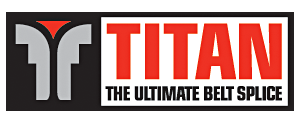
- Custom Manufactured for each Application
- High Quality Aluminum Construction
- For Belts 1200 PIW and up
- Splice Sections Sized for Individual Belt Widths
- Weight: 6.4 lbs. Per each 2 inches of width.
- Metric Weight of Splice: 2.80 kgs Per each 50 mm of width
- Overview & Technical Information
- Comparison Chart
- Warning
- Media / Literature
Introducing the Maxi-Lift TITAN, the Ultimate Elevator Belt Splice. TITAN’s innovative design of solid aluminum construction and superior quality materials make other splices obsolete for heavy elevator belts. The TITAN is constructed of a central aluminum vice-grip section which is bracketed by two exterior solid aluminum clamps. Utilizing clamping force, and friction to secure its load, the belt ends are bent through a 75 mm radius to a 90° angle. The central wedge is equipped with a rubber backing on the pulley side to prevent belt wear due to pressure and friction generated in operation.
Features / Benefits
- High Grade, Lightweight Aluminum Construction
- HNBR Rubber Wedge Protects Backside of Belt
- Custom Engineered for Each Elevator
- Large Clamping Surface for secure Hold
Technical Information
- Rubberized wedge section suitable for use up to 320°F / 160°C.
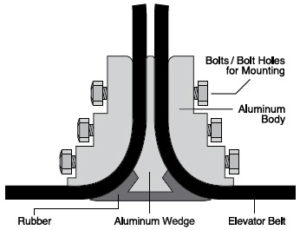
View/Print the Comparison Chart (PDF)
Belt Splice Technical Data Sheet
 | 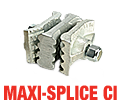 | 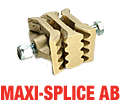 | 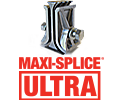 | 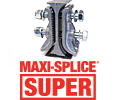 | 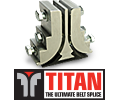 |
|
|---|---|---|---|---|---|---|
| PART DETAILS | Product | MAXI-SPLICE | MAXI-SPLICE | MAXI-SPLICE | MAXI-SPLICE | MAXI-SPLICE |
| Brand | CI | AB | ULTRA | SUPER | TITAN | |
| Part No | CI5 | AB5 | ULTRA5 | SUPER5 | TITAN | |
| SPLICE CONSTRUCTION | Color | Silver | Manganese Bronze | Silver | Silver | Silver |
| Construction | 3 Piece Mechanical Clamping Device | 3 Piece Mechanical Clamping Device | 3 Piece Mechanical Clamping Device with NBR (Nitrile) Rubber Wedge | 3 Piece Mechanical Clamping Device with NBR (Nitrile) Rubber Wedge | 3 Piece Mechanical Clamping Device with HNBR Rubber Wedge | |
| Metal Material | Galvanized Cast Iron | Manganese Bronze | Aluminum | Aluminum | Aluminum | |
| Metal Description | Ferrous Cast Iron | Non-Ferrous Bronze | High Grade, Lightweight Aluminum | High Grade, Lightweight Aluminum | High Grade, Lightweight Aluminum | |
| Rubber Material | None | None | Replaceable NBR Rubber Wedge | Replaceable NBR Rubber Wedge | Replaceable HNBR Rubber Wedge | |
| SPLICE SPECIFICATIONS | Weight (lbs.) | 2.6 | 2.9 | 1.93 | 4.8 | Per Application |
| Length | 3″ | 3″ | 4-1/2″ | 6-1/4″ | 6″ | |
| Width | 2″ | 2″ | 2-1/2″ | 3″ | Per Application | |
| PIW Rated | Up to 600 PIW Tensile | Up to 800 PIW Tensile | Up to 800 PIW Tensile | 800-1200 PIW Tensile | Over 1200 PIW | |
| Recommended Belt Thickness | 1/4″ to 5/8″ | 1/4″ to 5/8″ | 1/4″ to 5/8″ | 3/8″ to 3/4″ | Per Application | |
| BOLT SPECIFICATIONS | No of Bolts | 1 | 1 | 1 | 2 | Per Application |
| Bolt Grade | Grade 5 Hex Head Bolt | Grade 5 Hex Head Bolt | Grade 5 Hex Head Bolt | Grade 5 Hex Head Bolt | M16 10.9 Hex Head Bolt | |
| Bolt Diameter (Inches) | 1/2″ | 9/16″ | 5/8″ | 3/4″ | Per Application | |
| Bolt Length (Inches) | 5″ | 5″ | 4-1/2″ | 5″ and 5-1/2″ | Per Application | |
| Washers | Yes | Yes | Yes | Yes | Yes | |
| Nuts | Nylock | Nylock | Nylock | Nylock | Oval Lock Nut | |
| Recommended Torque * | 75 ft./lbs | 100 ft./lbs. | 125 ft./lbs. | 150 ft./lbs. | Per Application | |
| Template Tape Included | Yes | Yes | Yes | Yes | Requires Special Template | |
| SHIMS | Required Shims Per Belt Thickness | N/A | N/A | Under 5/16” – No Shims 5/16” to 3/8” – 1 Shim 3/8” to 1/2” – 2 Shims | Under 1/2” – No Shims 1/2” to 5/8” – 1 Shim 5/8” to 3/4” – 2 Shims | N/A |
| TEMPERATURE RATINGS | Max. Operating Temps | 600° F / 350° C | 500° F / 260° C | 200° F / 93° C (NBR Rubber Wedge Limiting Factor) – Alternative Wedges Available for Higher Temperatures | 200° F / 93° C (NBR Rubber Wedge Limiting Factor) – Alternative Wedges Available for Higher Temperatures | 320° F / 160° C (HNBR Hydrogenated Nitrile Butadiene Rubber Wedge Limiting Factor) |
| Nylock Nut Max. Temp | 250° F | 250° F | 250° F | 250° F | 320° F | |
| MINIMUM HEAD PULLEY DIAMETER | Agricultural (High Speed) ** | 12″ | 12″ | 24″ | 30″ | 48″ |
| Industrial (Centrifugal/Gravity) | 12″ | 12″ | 20″ | 36″ | 48″ | |
| BUCKET PROJECTION | Minimum Recommended | 4″ | 4″ | 5″ | 7″ | 8″ |
| FEATURES/ BENEFITS | Strong, Standard, Mechanical Splice | Non-Sparking, Non-Corroding, Non-Rusting | Non-Sparking, Non-Corroding, Non-Rusting, Longer Belt Life | Non-Sparking, Non-Corroding, Non-Rusting, Longer Belt Life | Non-Sparking, Non-Corroding, Non-Rusting, Longer Belt Life |
WARNING: DO NOT USE ANY MAXI-SPLICE ON MANLIFTS!
Please read all instructions before installing any Maxi-Splice product. Instructions can be found at maxilift.com. Failure to follow installation instructions may result in splice failure. As with any belt splice, continuous, regular inspections are required or failure can occur.
Never mix Maxi-Splice products on a single installation. Reduced or uneven clamping pressure may occur compromising splice integrity and could result in splice failure.
Maxi-Lift neither solicits nor recommends the use of any Maxi-Splice belt clamp for splicing man-lift belts. Maxi-Splices were neither designed for nor tested for this purpose. Any installation of a Maxi-Splice product for this purpose may result in splice failure causing serious bodily harm or even death. Do not use on steel cable belts.
Do not reuse nylon insert lock nuts when reinstalling Maxi-Splices. Please use new nylock nuts for reinstallation. Replacements are available from Maxi-Lift.
For applications exceeding 250° F, nylon insert lock nuts may not be used, as this temperature range exceeds the manufacturer’s threshold for nylon integrity. Compression locking nuts should be utilized instead.
While the AB and CI Maxi-Splice may be used on wing pulleys, they may contribute to wear on the backside of the belt at the splice. It is the user’s responsibility to inspect the splice at regular maintenance intervals to prevent failure. Noise may also be heard as the splice contacts the wings of the pulley.
Complete your Build
A single shipment, on a single invoice, from a single source: Maxi-Lift. For a limited time only, Maxi-Lift is offering 3% OFF on new bundle orders. Contact us today or call (800) 527-0657 for more information!
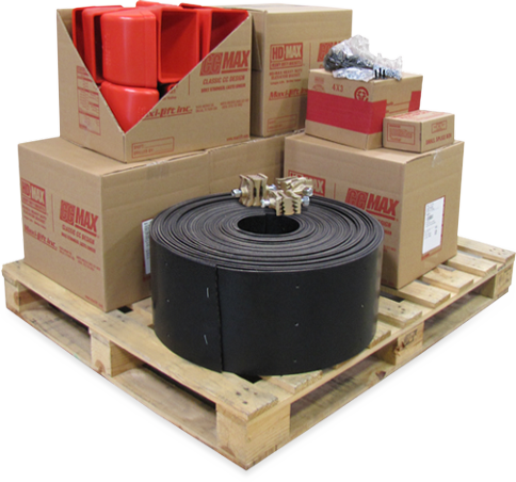
Subscribe
Join our mailing list to stay up to date with what is happening at Maxi-Lift, Inc.

